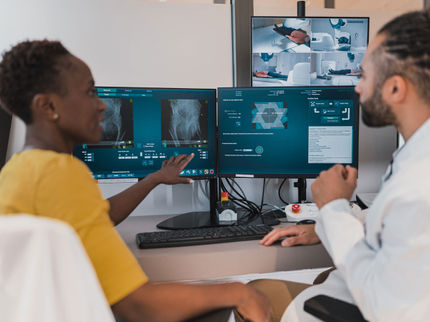Protein could help in early detection of malignant Hodgkin's lymphoma
Hodgkin's lymphoma is one of the most common forms of lymphatic cancer and is most common in young adults. How this malignant disease of the lymphatic system occurs has not yet been fully clarified. Scientists at the Medical Faculty of the University of Duisburg-Essen (UDE), together with researchers at the University Hospital Frankfurt am Main, are now closing further gaps in the history of Hodgkin's lymphoma. Thanks to their findings, diagnoses could be made more reliably in the future and better therapies developed through further research. The research has been funded by the Wilhelm Sander Foundation with approximately 176,000 euros for 24 months.

Prof. Dr. Ralf Küppers, Institute for Cell Biology (Tumor Research) at Essen University Hospital
Martin Kaiser, UK Essen
The experts are focusing on the protein "CD30". Its existence on a cell surface is regarded as an essential indication that a Hodgkin's lymphoma has formed. However, the research teams from Essen and Frankfurt am Main suspect after their investigations that the mere presence of CD30 is not always an indicator of such a malignant cancer. "Sometimes CD30 molecules are also found on a rare form of immune cell," says Prof. Dr. Ralf Küppers of the Institute of Cell Biology (Tumor Research) at Essen University Hospital. Together with Prof. Dr. Martin-Leo Hansmann from the Frankfurt Institute for Advanced Studies, the teams were able to prove that the accumulations of CD30 found on rare immune cells do not represent a precursor of Hodgkin's lymphoma.
In addition, the researchers investigated whether possible gene alterations are involved in the development of Hodgkin's lymphoma and which ones. In the form of a first partial result, they were already able to show that a gene for a specific regulator of gene activities loses its function in some Hodgkin lymphoma cases due to mutation. Further studies on the detected gene alterations could lead to new starting points for more targeted Hodgkin lymphoma therapies in the future.
Note: This article has been translated using a computer system without human intervention. LUMITOS offers these automatic translations to present a wider range of current news. Since this article has been translated with automatic translation, it is possible that it contains errors in vocabulary, syntax or grammar. The original article in German can be found here.
Original publication
Other news from the department science

Get the life science industry in your inbox
By submitting this form you agree that LUMITOS AG will send you the newsletter(s) selected above by email. Your data will not be passed on to third parties. Your data will be stored and processed in accordance with our data protection regulations. LUMITOS may contact you by email for the purpose of advertising or market and opinion surveys. You can revoke your consent at any time without giving reasons to LUMITOS AG, Ernst-Augustin-Str. 2, 12489 Berlin, Germany or by e-mail at revoke@lumitos.com with effect for the future. In addition, each email contains a link to unsubscribe from the corresponding newsletter.






















































